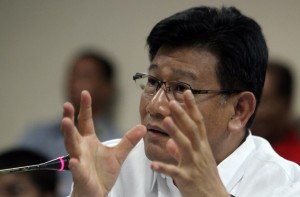BAGUIO CITY—The Philippines is ready to cut its greenhouse gas emissions and help save the planet, even if it may negatively affect the country’s economic growth, Environment Secretary Ramon Paje said here on Saturday night during the Baguio leg of the Earth Hour ceremonies.
Paje said the government’s climate change cluster was still working out the numbers to determine the volume of carbon emissions the Philippines would be able to reduce before it commits to cuts in December at the United Nations Climate Change Conference in Paris.
The cuts will be painful because the commitment will require the public to moderate energy use and utilize energy-saving or clean-energy technologies that are more expensive than conventional ones, according to Paje.
“Our economy is growing and that means more electricity is consumed and more vehicles are on the streets expelling carbon gases. Cutting emissions to 1990 levels, as we intend to offer in December, would be inversely proportional to the improved gross domestic product (GDP) of the country,” he said.
GDP measures the value of goods produced and services rendered in a country in a given period.
Review lifestyles
“The public must be compelled to review its day-to-day lifestyles. We also need to adopt technologies available in other countries, like electric cars,” Paje said.
Paje acknowledged that to cut greenhouse gases, the Department of Energy (DOE) may be required to increase its reliance on renewable energy.
Currently, coal-fired power plants remain the cheapest source of electricity in Luzon, although the DOE has encouraged investors to build more renewable power plants to balance out the environmental impact of coal, said Energy Secretary Jericho Petilla, when he attended a DOE forum here in February.
Paje noted that Germany is marketing a new electric car, which is more energy efficient and could be available in the Philippines within three years.
The Philippine government has advocated the use of electric jeepneys, Paje said.
Forest delineation
It has also finalized a forest delineation program, which defines precise boundaries for woodlands, settlements and farms in the provinces. This will ensure the preservation of forests that aid in counteracting the impact of carbon dioxide in the atmosphere, he said.
These developments assure the public that the Philippines is ready to take radical steps in the Paris talks.
The Paris conference is the most crucial stage of global negotiations to draw up new international binding agreements to control industry emissions or reduce a nation’s consumption patterns once the Kyoto Protocol lapses, the UN Framework Convention on Climate Change (UNFCC) said on its website.
The Kyoto Protocol is an international agreement that commits its parties by setting internationally binding emission reduction targets.
“Recognizing that developed countries are principally responsible for the current high levels of GHG (greenhouse gas) emissions in the atmosphere as a result of more than 150 years of industrial activity, the protocol places a heavier burden on developed nations under the principle of ‘common but differentiated responsibilities,’” the UNFCC said.
The Kyoto Protocol was adopted in Kyoto, Japan, on Dec. 11, 1997, and came into force on Feb. 16, 2005. The United States did not ratify the protocol.
The carbon dioxide and carbon monoxide each country expels into the atmosphere “are what cause climate change, but we can still solve that problem,” Paje said.
Once the Kyoto Protocol lapses in 2020, the Paris agreement takes effect.
Paje said the new agreements would obligate not just developed nations but also developing countries like the Philippines.
